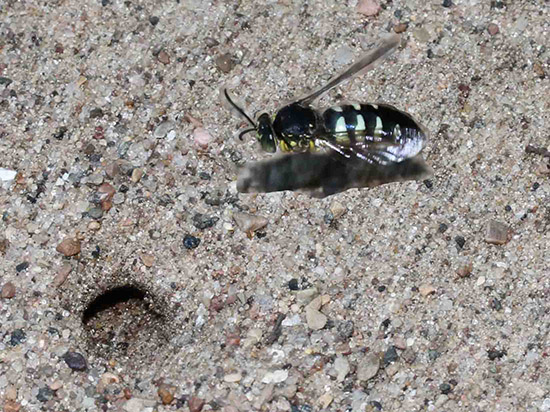Issue 1, April 24, 2017
Sand Wasps
Sand wasps have similar habits to the cicada killer, but they occur earlier in the spring, with other species common later in the growing season. There are several species, ranging in size from 1/2 to almost 1 inch long. They are dark-colored, slender wasps with one or more contrasting gray to reddish bands. Adults feed on flower nectar, pollinating plants in the process.
Females dig burrows in sandy or other soil, preferring areas bare of vegetation. These burrows descend several inches and have loose soil around the entrance. Depending on the species, adult females capture flies, beetles, crickets, camel crickets, or katydids. One species specializes in attacking adult metallic woodboring beetles, and its nests are used in surveying for emerald ash borer. The female drags the individual stung and paralyzed prey item to the bottom of the burrow, lays an egg on it, and then fills in the burrow opening. She digs a series of burrows, repeating the process. The egg hatches into a larva that eats the prey and pupates in the burrow, emerging during the following growing season.

Sand wasp adult flying to burrow.
These wasps are unlikely to sting. Wasp and bee stingers are modified egg-laying devices, so males are not equipped to sting. Females sting if crushed, as when stepped on barefoot or grabbed by bare hands.
Though these wasps are not dangerous, they are intimidating. In home lawns, educating the human residents may foster tolerance. Wasps are more common in bare soil areas, so sodding, planting ground-covers, or mulching may greatly reduce the problem.
Nesting areas in public areas become a major problem. Insecticide dusts applied to dry sand or soil are more effective than sprays. Application of carbaryl (Sevin Dust), deltamethrin (DeltaDust) or other labeled insecticide to the burrow area should kill them in golf course bunkers.
Cover sandboxes when children are not using them, and this deters the wasps (human mothers will think the covers are to keep house cats out). This also works for sand volleyball courts as most are not used for several hours on weekdays. These are day-active wasps, so if their nests are not available to them for several hours most days, they will search for other nest locations. Replace sand below children's swings, jungle gyms, and other playground equipment with bark mulch or shredded tires. (Phil Nixon)
Author:
Phil Nixon